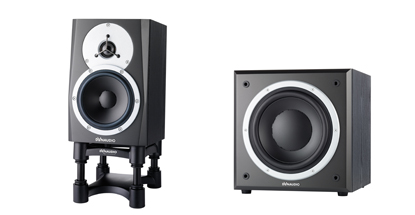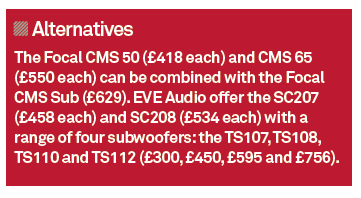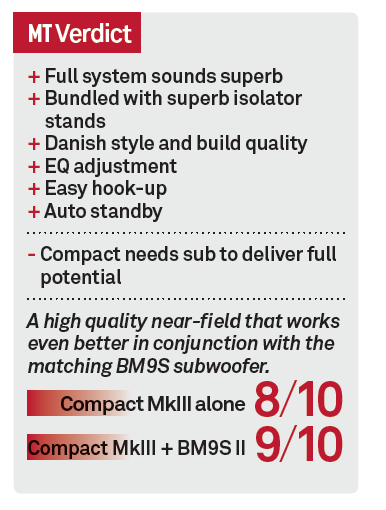Dynaudio BM Compact MKIII Review
Dynaudio has made plenty of changes for the third generation BM Series, approaching the redesign from an overall ‘system’ point of view. Huw Price tests the Compact MkIII… Details Price Compact MkIII £514 (each) BM9S II £946 Contact TC Electronic 0800 9178926 Web www.dynaudio.com The BM Compact MkIII is the newest and smallest addition to […]

Dynaudio has made plenty of changes for the third generation BM Series, approaching the redesign from an overall ‘system’ point of view. Huw Price tests the Compact MkIII…

Details
Price Compact MkIII £514 (each)
BM9S II £946
Contact TC Electronic 0800 9178926
Web www.dynaudio.com
The BM Compact MkIII is the newest and smallest addition to Dynaudio’s BM Series. It’s described as ‘a premium quality, small-format near-field monitor’. A new low frequency driver has been installed for the Compact, using technology taken from Dynaudio’s Air 25 Series, and it features ultra lightweight aluminium wire and a small aluminium voice coil for greater excursion.
As a result of a partnership between IsoAcoustics and Dynaudio, every monitor in the BM series comes bundled with a Dynaudio branded ISO-L8R stand. As well as acoustically isolating the speakers from any surface they’re place on, these stands enable you to adjust the angle of your monitors to match your listening position.

Dynaudio chose them because they think they’re the ‘best and most flexible product on the market’ and, having owned a pair for a few years, we’re not disputing that assessment. Wall-mounting brackets specially designed for the BM Series are also available, if that’s more your thing.
Audio inputs are made via balanced XLR or unbalanced RCA, and a three-position level switch (-10, 0 and +4dB) is preferred to a rotary volume control. Accompanying the on/off there’s a power mode switch for auto sleep or permanent ‘on’ status.
The bass can be boosted or cut by 2dB at 60Hz or 80Hz, but the Flat setting is recommended unless you’re using the Compact BM MkIII with a subwoofer. Although the frequency points are not specified, the treble can be adjusted by 1dB either side of flat, and the midrange can be attenuated by 2dB or 4dB. The ‘Remote’ socket also enables users to connect a Dynaudio Volume Box level controller.

The Lowdown
The BM Series includes two Subwoofers: the BM14S II, and the smaller BM9S II that was sent for this review. A 200W Class D amplifier feeds a 10in woofer in an infinite baffle enclosure. There are two operating modes: LFE and Sat/Sub, with different inputs for each plus a Slave output. Rotary controls are provided for Gain and Sub Lowpass with a range from 50-150Hz.
The Flat/60Hz/80Hz settings of the high-pass filter correspond to the Compact’s, and there’s a polarity switch to help with system integration.
We performed listening tests in two stages, with and without the subwoofer. As a regular stereo pair the Compacts combine a wide soundstage with the full low midrange and strong upper bass that many might associate with the brand.

The big, impressive, up front and informative sound is genuinely pleasurable to experience. However the Compact’s sound does have a degree of character, which may require an acclimatisation period. For instance, the fulsome low mids seem to dominate the upper midrange to some degree, resulting in mix elements such as room ambience and the shell tones of snare drums being harder to discern. Lead vocals also sit noticeably deeper in the mix than they might on other monitor systems.
Dynaudio’s Fred Speckeen acknowledges these midrange characteristics but assures us that the Compact’s response is flat when deployed in acoustically flat rooms and advises applying the midrange filtering in less-than-ideal spaces. We found it helped, but the frequency centre of the cut seemed slightly above the problem area.

All Together Now
Setting up the sub was a breeze and we set the bass roll-off and high-pass filter to 80Hz for the Compacts and BM9S II, respectively. The gain level of the sub was adjusted by ear, and very little was needed to achieve a balanced sound. Sweeping through the bass range with an oscillator showed that the system performed smoothly with no peaks or troughs from 110Hz down to 30Hz.
Although the Compact MkIII is an accomplished speaker on its own, we found that the addition of the BM9S elevated its performance. There was an immediate improvement in clarity, image depth and imaging. Most importantly the midrange detail was significantly enhanced. The Compact worked superbly with the BM9S II, so if your budget will stretch to it, buying the entire system would definitely be the preferable option.




